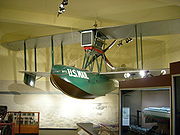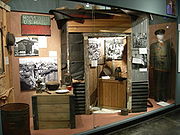
Museum of History and Industry
Encyclopedia


Museum
A museum is an institution that cares for a collection of artifacts and other objects of scientific, artistic, cultural, or historical importance and makes them available for public viewing through exhibits that may be permanent or temporary. Most large museums are located in major cities...
located in the Montlake neighborhood of Seattle, Washington, United States
United States
The United States of America is a federal constitutional republic comprising fifty states and a federal district...
.
Accredited by the American Association of Museums, MOHAI is "dedicated to enriching lives by preserving, sharing and teaching the diverse history of Seattle, the Puget Sound region and the nation."
History
MOHAI's story starts almost a century ago. In 1911, Morgan and Emily Carkeek hosted the first annual Founder's Day party at their home, which was an invitation-only event where guests dressed in historic costumes and brought artifacts and documents related to early Seattle. An outcome of these parties was the establishment of the Seattle Historical Society in 1914, the membership of which was limited to white settlers and their descendants.The Seattle Historical Society lacked a building to house their museum. Several attempts to find a permanent location were abandoned because of challenging financial circumstances, especially during the Depression, and the fact that the original society members were aging and new members were hard to come by. The collection continued to grow, however. In 1945, Boeing offered $50,000 towards an aviation wing, and over the next 5 years, the Society successfully procured its present site in Montlake. During this time the Society became a more public and civically-minded institution, opening up the Founder's day to community and service organizations. The new museum opened in 1952.
Over the last 50 years, the museum has experienced ups and downs. Management practices of the museum and collections, membership, and the relationship to its immediate surroundings, have also been problematic over the years. Changes in the 1980s that moved the museum forward in a positive direction included developing new exhibits and reaching out to underrepresented communities, but were a shock to older staff and board members. During the 1990s the museum gradually recovered from these internal challenges, as well as financial ones, and began expanding educational and community outreach programs. Currently, the museum expects to relocate to the former Naval Reserve Training Center, or "Armory," in Seattle's South Lake Union neighborhood.
Organizational structure
The museum employs 35 permanent staff members. Departments include Administration and Development, Education, Public Programs and Events, Collections, Exhibits, Library and Archives, Visitors Services, and Communications.Audience
MOHAI targets visitors from the Seattle-area, school groups, and tourists. It is visited by over 60,000 people annually.Permanent exhibits
MOHAI's permanent exhibits cover several different periods of Seattle's and the region's history. The exhibit is divided into "This Native Land" (1792–1859) about native settlement and early European exploration and settlement; "Little Town on Elliott Bay" (1859–1889) about the period until Washington statehood and the Great Seattle FireGreat Seattle Fire
The Great Seattle Fire was a fire that destroyed the entire central business district of Seattle, Washington, USA, on June 6, 1889.-Early Seattle:In the fall of 1851, the Denny Party arrived at Alki Point in what is now the state of Washington...
(both 1889); "Boom Times, Hard Times" (1889–1940) covering, especially, the Klondike Gold Rush
Klondike Gold Rush
The Klondike Gold Rush, also called the Yukon Gold Rush, the Alaska Gold Rush and the Last Great Gold Rush, was an attempt by an estimated 100,000 people to travel to the Klondike region the Yukon in north-western Canada between 1897 and 1899 in the hope of successfully prospecting for gold...
and Alaska-Yukon-Pacific Exposition
Alaska-Yukon-Pacific Exposition
The Alaska–Yukon–Pacific Exposition was a world's fair held in Seattle in 1909, publicizing the development of the Pacific Northwest.It was originally planned for 1907, to mark the 10th anniversary of the Klondike Gold Rush, but the organizers found out about the Jamestown Exposition being held...
and the Great Depression
Great Depression
The Great Depression was a severe worldwide economic depression in the decade preceding World War II. The timing of the Great Depression varied across nations, but in most countries it started in about 1929 and lasted until the late 1930s or early 1940s...
; "Homefront" (1941–1945) about Seattle during World War II
World War II
World War II, or the Second World War , was a global conflict lasting from 1939 to 1945, involving most of the world's nations—including all of the great powers—eventually forming two opposing military alliances: the Allies and the Axis...
and the U.S. homefront
United States home front during World War II
This page, United States home front during World War II, covers the developments within the United States, 1940–1945, to support its efforts during World War II.-Economics:...
more generally; "Our Own City" (1946–present) covering the suburb
Suburb
The word suburb mostly refers to a residential area, either existing as part of a city or as a separate residential community within commuting distance of a city . Some suburbs have a degree of administrative autonomy, and most have lower population density than inner city neighborhoods...
an boom, the American Civil Rights Movement, and the rise of companies such as Microsoft
Microsoft
Microsoft Corporation is an American public multinational corporation headquartered in Redmond, Washington, USA that develops, manufactures, licenses, and supports a wide range of products and services predominantly related to computing through its various product divisions...
.
Other permanent exhibits include "Salmon Stakes" (covering a sweeping history of the salmon
Salmon
Salmon is the common name for several species of fish in the family Salmonidae. Several other fish in the same family are called trout; the difference is often said to be that salmon migrate and trout are resident, but this distinction does not strictly hold true...
fishery); "Icons and Eye Candy" with exhibits such as a Boeing B-1 seaplane, the Lincoln Towing Co.'s original Pink Toe Truck, and the once famous and now taxidermically
Taxidermy
Taxidermy is the act of mounting or reproducing dead animals for display or for other sources of study. Taxidermy can be done on all vertebrate species of animals, including mammals, birds, fish, reptiles, and amphibians...
stuffed Bobo the gorilla
Bobo (gorilla)
Bobo was a western lowland gorilla who was a prominent feature of Woodland Park Zoo in Seattle, Washington, USA, from 1953 until his death...
; numerous ship's figureheads; and several works of art from now-demolished or remodeled Seattle buildings, including Jean Cory Beall's 1958 mosaic from the old Seattle City Light
Seattle City Light
Seattle City Light is the public utility providing electrical power to Seattle, Washington and parts of its metropolitan area, including all of Shoreline and Lake Forest Park and parts of unincorporated King County, Burien, Normandy Park, Seatac, Renton, and Tukwila...
building; and numerous large panels by Kenneth Callahan
Kenneth Callahan
Kenneth Callahan was a noted 20th century Abstract Expressionism painter, art critic curator, and a founder of the Northwest School....
, formerly in the Marine Hospital (now Pacific Medical Center). In addition, the Gift Shop has the Rainier Brewing Company
Rainier Brewing Company
Rainier Brewing Company was a Seattle, Washington, company that brewed Rainier Beer, a popular brand in the Pacific Northwest of the United States. Although Rainier was founded in 1884, the Seattle site had been brewing beer since 1878. While the beer enjoys near iconic status, it is no longer...
's old red "R", which used to be on top of the brewery next to Interstate 5
Interstate 5
Interstate 5 is the main Interstate Highway on the West Coast of the United States, running largely parallel to the Pacific Ocean coastline from Canada to Mexico . It serves some of the largest cities on the U.S...
.
Temporary Exhibits
Recent temporary exhibits are wide ranging, and include traveling exhibits such as "Lincoln: Constitution and Civil War," "Finding Your Way: Human Navigation," and "Theatre de la Mode," and "The Art of Warner Bros. Cartoons." Upcoming in-house Exhibits include "Photographing the Fair: The AYPE Photos of Frank H. Howell and Others," developed as part of Seattle's city-wide centennial celebration of the Alaska Pacific Yukon Exposition in 2009, and "The Arts and Crafts Movement in the Pacific Northwest," developed as a traveling exhibition.Education Programs
The K-12 programming at MOHAI is designed to complement the permanent exhibition, "Essential Seattle: A City Revealed, a Future Imagined." Programs are designed to support teachers through meeting state curriculum standards, and offering professional development opportunities; use primary sources to promote critical thinking; present multiple perspectives to explore diverse experiences and histories that make up Seattle's story; make history relevant with personal connections; and create links across academic disciplines.Onsite programs for students are designed to complement the permanent exhibition. Students use primary sources to explore Seattle's stories, gather evidence to crack history mysteries, and explore facts and myths about Seattle's past.
Outreach resources include themed trunks that include artifacts, audio/visual resources, and adaptable activities that are aligned to state curriculum standards. Themes range from Native American People of Washington State, to the Settlers of Washington State, to the War Years. Themed packets of visual resources include photographs and slides, background histories and activities. Themes include Early Recreation in Seattle, Changing Scenes of Downtown Seattle, and Women in Washington History. Finally, a reader's theater script, drawn from primary sources relating to the Gold Rush, comes with stage directions.
MOHAI also organizes professional development opportunities for teachers, to strengthen their understanding of Seattle's history, object-based learning, and curriculum standards.
Collections
MOHAI has around 4 million objects in the collection, including around 100,000 artifacts, and 1.5 million photographs, and extensive archives. Collections focus on Seattle's early settlement (ca. 1850) through present-day, and concentrate on the stories and achievements of Seattle's residents. Artifacts highlight significant contributions by Northwest businesses such as Microsoft, Boeing, and Starbucks, artifacts related to significant Seattle families such as the Mercers and the Dennys, and artifacts from events such as the Alaska Yukon Pacific Exposition, Century 21 World's Fair, WTO riots, etc. It is best known for its photographic collection. The archival collection also includes oral histories which are accessible through the website, and are occasionally interpreted for public programs and member events.Collection Highlights:
The B-1: Boeing's first plane,
Slo-Mo-Shun IV Hydroplane,
Bobo the Gorilla,
Neon sign collection, and
Seattle's first fire bell.
Archives Highlights:
Seattle Post-Intelligencer Photographic Collection, and the
MOHAI OSPI Oral History Project.

